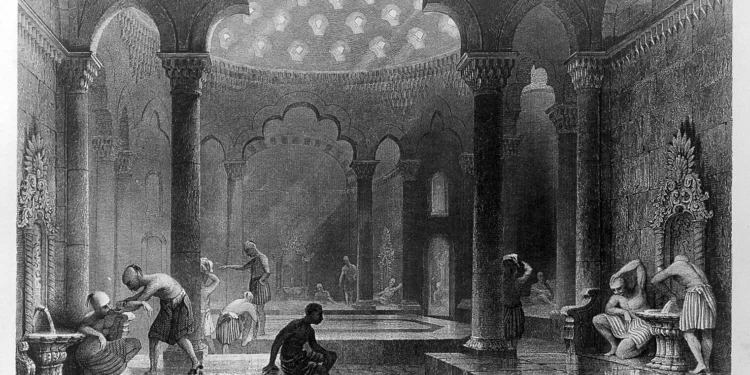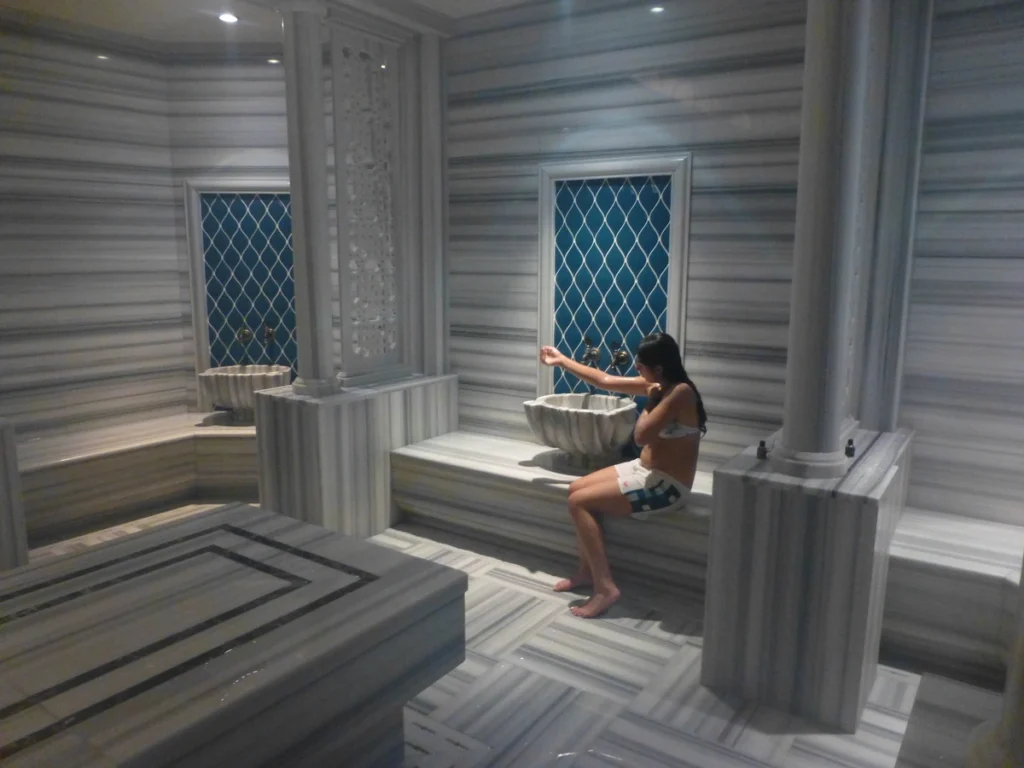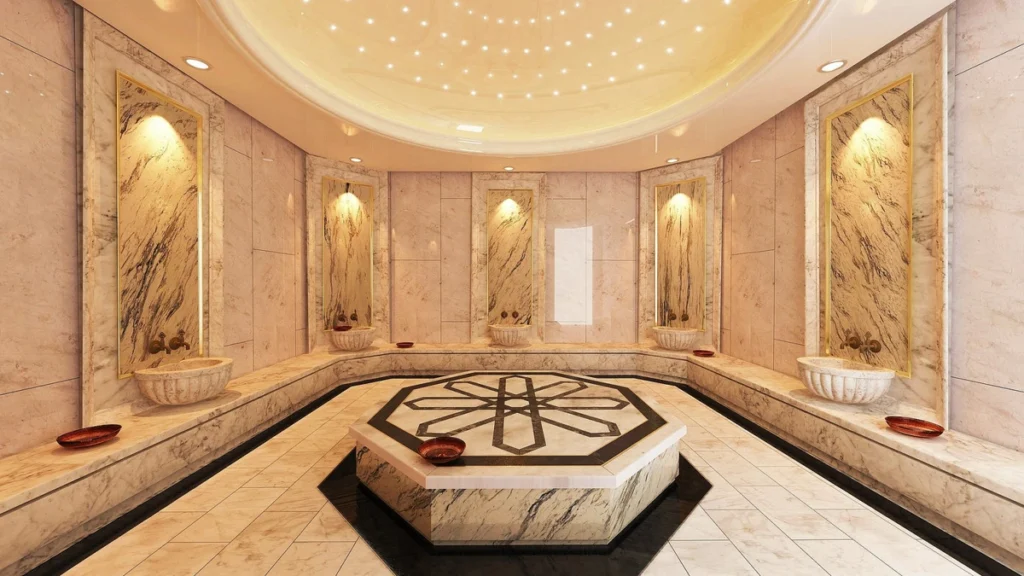The Turkish Hamam, also known as the Turkish bath, is a significant cultural tradition with roots going back to the Roman and Byzantine bathhouses. Over the centuries, it has evolved to become a defining feature of Ottoman and Turkish culture. A hamam is not just a place for physical cleansing but also a social, spiritual, and historical institution.
Table of Contents
Historical View of Turkish Hamam
- Origins: Roman and Byzantine Influence (2nd century BCE – 6th century CE)
- The Roman baths, which were extensive public facilities spread throughout the Roman Empire, are thought to have served as the model for the Turkish custom of communal bathing. The Byzantines further embraced the bathing culture that the Romans introduced to Anatolia (present-day Turkey).
- Public baths served as hubs for rest and conversation because the Romans placed high importance on cleanliness and social interaction.
- Ottoman Adoption (14th century onwards)
- When the Ottoman Empire came of age (from the 14th century onwards), they carried on the bathhouse tradition but made their own cultural adaptations, taken from Islam.
- Islamic ritual hygiene, or “Wudu” (ablution), came to play a central role. Although the Hamam was primarily a ritual for hygiene, it was also a spiritual practice, particularly for praying.
- Ottoman bathhouses incorporated not just bathing, but social and communal activity into urban life, at least among the elite. Every age would come to the Hamam, though classes were distinguished by different rooms or opening hours.
- Golden Age of Hamams (16th century)
- A golden age of grand public baths developed during the 16th century, under Sultan Suleiman the Magnificent. The Ottoman architect Mimar Sinan constructed great Hamams, including the Haseki Sultan Hamam and Çemberlitaş Hamam in Istanbul.
- Such baths often boasted magnificent Ottoman designs, featuring elaborate domes, marble floors and fancy fountains.
- Modern Day
- In Turkey today, Hamams are as important as ever, although the modern shower has made them less important for everyday hygiene.
- They are still popular with residents and visitors, especially in Istanbul, Bursa and Cappadocia, for their historical importance and uniqueness.
Hamam Experience: Ritual and Process
- Warm Room (Tepidarium):
- First, they enter a room with a heater so they can chill and get used to the heat. It’s a humid room, with heated marble plinths. This step opens up the pores and prepares the body for deep cleansing.
- Hot Room (Hararet):
- The next step is the hot room, which is sweltering. Visitors lie or squat on a Göbek Taşi (heated marble slab in the center) to expel toxins. This is an essential part of softer skin.
- Scrubbing (Kese):
- After a period of sitting in the hot room, an attendant, a tellak (male) or natir (female), completes the kese (exfoliation) with a rough mitt made of goat’s hair or other natural fibers. This removes dead skin cells.
- Foam Massage:
- After the exfoliation, a lavish bubble bath (sabunlama) occurs. Through soap and a plastic bag, the attendant creates fluffy bubbles, which are then rubbed into the skin.
- Rinsing:
- Following the foam massage, guests are drenched in water, typically poured from traditional copper or brass sinks. This completes the main cleansing ceremony.
- Cold Room (Sogukluk):
- The final step is to cool down in the cold room. Customers are invited to have a drink, relax and, occasionally, even be given additional services such as oil massages.
Traditions and Cultural Significance
- Social Space:
- Turkish Hamams are traditionally gathering spaces. Women regularly visited Hamams prior to major life events (weddings or childbirth) to cleanse and revitalize. Wedding baths (gelin hamam) were an important pre-marital ritual.
- Males would meet at Hamams to socialize, argue politics or business discussion, or simply hang out with friends.
- Ritual Purity:
- Islamic beliefs regarding cleanliness contributed to the Hamam’s role in preparing individuals for prayer. Cleansing in a hamam symbolized both outer and inner purification.
- Architectural Beauty:
- Several of the older Hamams are works of Ottoman art, consisting of domes with tiny glass windows to let in the light, elaborate fountains and marble interiors.
Costs (GBP)
A typical Turkish hamam experience can cost anywhere between £10 to £100, depending on where you go and how much service you receive. For example, in large tourist destinations such as Istanbul, prices can run from low-cost public baths to costly Hamams at expensive hotels. Here is a breakdown of the prices:
- Basic Entry:
- In a basic hIn a simple hamam, which you clean and scrub yourself (DIY), costs as little as £10 to £20.
- Standard Hamam Experience:
- A traditional experience (with entrance, scrubbing and foam massage by an attendant) usually costs between £25 and £50.
- Luxury Hamams:
- Prices at more expensive or historical Hamams, like the Ayasofya Hurrem Sultan Hamam or Çemberlitaş Hamam, run from £60 to £100, depending on whether you add extras such as oil massages or longer treatments.
- Tourist Packages:
- A few luxury hotels and resorts offer Turkish hamam treatments as wellness treatments in addition to spa treatments. These can cost £150 or more, particularly at 5-star venues.
Famous Hamams in Turkey
- Çemberlitaş Hamamı (Istanbul):
- This is one of the most well-known Turkish Hamams, it was built by Mimar Sinan in 1584 and is of great architectural value.
- Ayasofya Hurrem Sultan Hamamı (Istanbul):
- A Turkish hamam built for Sultan Suleiman’s wife Hurrem Sultan, it is situated near the Hagia Sophia and offers a luxurious bathing experience.
- Suleymaniye Hamamı (Istanbul):
- A second of Mimar Sinan’s best-known compositions, this Turkish hamam, which is attached to the Süleymaniye Mosque, has a traditional, family-friendly feel.
- Kadirga Hamamı (Bursa):
- In Bursa, the hot springs are popular places to visit for Hamams, where the thermal waters are known to cure all sorts of ailments.
Conclusion
The Turkish Hamam is an interesting combination of culture, tradition and relaxation. It is a very special way of discovering Turkish tradition both locally and abroad at prices that range from affordable to expensive. Either as a form of healthcare, a place to mingle or simply to simply gaze upon its beauty, the Turkish Hamam has always been a central symbol of Turkish heritage.










